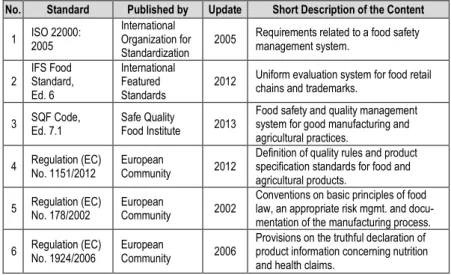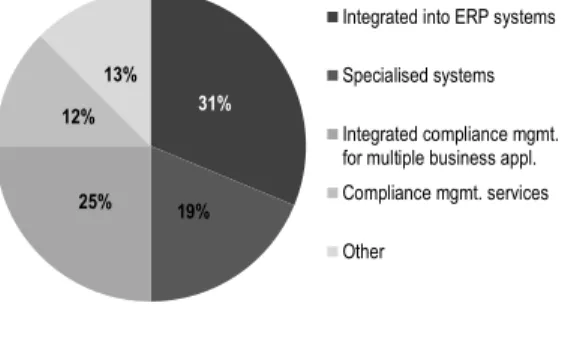A Survey on Compliance Standards
and their IT-Support in the Nutrition Industry
Andrea Zasada, Michael Fellmann University of Osnabrück
Institute of Information Management and Business Administration Katharinenstraße 3
49069 Osnabrück
{andrea.zasada | michael.fellmann}@uni-osnabrueck.de
Abstract: Compliance standards are necessary to ensure that enterprises adhere to important laws and regulations concerning their business. To overcome the diversi- ty of laws and regulations, software companies have promised to support the en- terprises by appropriate software solutions. Consequently, new compliance man- agement systems have been brought to the market and existing business applica- tions have been extended by compliance functionalities. The following approach analyses whether significant compliance standards for the nutrition industry have been sufficiently implemented.
1 Introduction
For the last few years, the nutrition industry has been affected by several scandals in- cluding misleading product declarations and spoiled food [Sh10]. Resulting from this bad publicity, products were withdrawn from the market and supply chains became mon- itored. However, the damage was already done. Customers had already lost their confi- dence in the affected product and its supplier. To improve food safety during the manu- facturing process, the European Union and other transnationally operating foundations established specific compliance regulations. Compliance regulations can be divided into laws and official standards, best practice frameworks and company specific commit- ments [LSG07]. Standards, like the regulations of the European Community (EC) and the International Organization for Standardization (ISO), help companies to adhere to and apply important laws. The EC directives, for example, formulate requirements, which support companies in identifying critical instances in the manufacturing process.
Together with related standards and best practice frameworks (e.g. COSO, COBIT), they define elaborate guidelines to evaluate and conquer potential risks of non-compliance [Ti08]. This paper systematically explores whether the provider of information systems offer appropriate compliance management solutions for the nutrition industry. Six of the most significant compliance standards have been chosen, which will be described in section 2. These standards provide information on typical requirements for the nutrition industry concerning food safety, quality and risk management as well as related docu-
mentation obligations. The results will be used to evaluate available business application systems for the compliance management in section 3. Section 4 gives a brief summary of the findings.
2 Existing Compliance Standards in the Nutrition Industry
In general, compliance is “the act of obeying an order, rule, or request” [Cad08]. For enterprises, compliance means to ensure that business activities conform to relevant standards, regulations, and other requirements. This includes the adherence to standards, which have been formed by the characteristics of a particular industry sector. Table 1 presents an overview on compliance standards supervised by the International Organiza- tion for Standardization (ISO), the International Featured Standards (IFS), the Safe Qual- ity Food Institute (SQF) and the European Community (EC). The first three compliance standards, given in Table 1, focus on the requirements of a food safety and quality man- agement to establish a transparent and uniform manufacturing practice. The other stand- ards comprise quality rules and required product specifications concerning nutrition and health claims.
IFS and SQF are both benchmarked by the Global Food Safety Initiative, a non-profit organization promoting the continuous improvement of food safety management systems [If13; Sq13]. The two standards are based on other guidelines, suitable to analyze critical points in the manufacturing process. Related principles and guidelines are the Good Manufacturing Practice (GMP), the Hazard Analysis and Critical Control Points (HACCP) and the Quality Management Standard ISO 9001:2008. Obviously, current information systems have to cope with a wide range of content-related requirements on the one hand and system requirements on the other. In section 3 it will be investigated, if the presented standards of Table 1 are addressed by the top 100 European software com- panies.
No. Standard Published by Update Short Description of the Content 1 ISO 22000:
2005
International Organization for Standardization
2005 Requirements related to a food safety management system.
2
IFS Food Standard, Ed. 6
International Featured Standards
2012 Uniform evaluation system for food retail chains and trademarks.
3 SQF Code, Ed. 7.1
Safe Quality
Food Institute 2013
Food safety and quality management system for good manufacturing and agricultural practices.
4 Regulation (EC) No. 1151/2012
European
Community 2012
Definition of quality rules and product specification standards for food and agricultural products.
5 Regulation (EC) No. 178/2002
European
Community 2002
Conventions on basic principles of food law, an appropriate risk mgmt. and docu- mentation of the manufacturing process.
6 Regulation (EC) No. 1924/2006
European
Community 2006
Provisions on the truthful declaration of product information concerning nutrition and health claims.
Table 1: Compliance Standards in the Nutrition Industry
3 Survey on Available Offerings for Compliance Management
We explored the commercial offerings for compliance management based on the list of the top 100 European software companies available from SOFTWARETOP100.ORG (www.softwaretop100.org) (c.f. Table 1). Out of this list, we selected only vendors with offerings that explicitly address compliance. In the first two columns, Company and Product, we provide the name of the company and the product, if possible. In the Cat.- column we specify the type of the offering being a (1) specialized compliance manage- ment software, (2) an ERP-system with integrated compliance management functionali- ty, (3) integrated compliance management for multiple business applications, (4) ser- vices such as consulting or (5) other offerings. In the rightmost column Supp. we report on the explicit and (by the vendor) documented support that an offering provides in regard to the compliance standards introduced previously in Table 1. In Figure 1 we show the distribution of the offerings in respect to the five categories.
Company Product Cat. Short Description of the Offering Supp.
IBS AG CompliantPro 1 Comprises software for quality and compliance management as well as services. 1 Leitsch Software EASY ENTERPRISE 5 Document management system with integrated
compliance functionality. --
EPICOR GRC Software Solutions 2 ERP-software that addresses governance, risk
and compliance. --
IT Compliance
Systeme (Service Offering) 4 Analysis of the IT-infrastructure regarding the adherence to laws and best practices. --
Microsoft Microsoft Dynamics 2 Adaptable ERP and CRM solutions. (1)
Anaptis (Service Offering) 4 Various consulting services with respect to the
Microsoft Dynamics product. (1)
Software AG ARIS Risk & Compliance
Manager 1 Process-driven solution for enterprise-wide
governance, risk and compliance programs. -- IBM (Integrated Compliance Man-
agement Solutions) 3 Flexible solution covering e.g. ECM, web-
compliance mgmt. and other aspects. -- Symantec i3 for ERP and CRM; Control
Compliance Suite Risk Manager 1 Compliance aspects are partly addressed by i3;
Symantec Control is focused on compliance. 1 Cisco Systems Cisco Solutions 3 Various products with an overall emphasis on
data security and data transmission security. -- BMC Software BMC Remedy IT Service
Management Suite 3 Contains an IT-compliance management
software for governance and controls mgmt. --
SAP mySAP ERP 3 Provides features for data analysis, reporting,
finance and risk mgmt. e.g. for Sarbanes Oxley. -- Mentor Graphics Mentor Data Management
System 5 Document management system with integrated
compliance functionality. --
IQMS Manufacturing Execution
System 2 The system provides interfaces to ERP-
systems implementing compliance features. -- TIBCO Software TIBCO LogLogic 2 Connects to ERP-system and provides monitor-
ing, audit processing, and compliance features. -- accenture Accenture Audit and Compli-
ance Tool 2 Geared towards HR and IT-departments,
mainly for personnel-related data mgmt. -- Table 2: Commercial Offerings for Implementing Compliance in the Nutrition Industry
Looking at the rightmost column of Table 1, it has to be noted that there is almost no officially documented sup- port available for the compliance standards relevant for the nutrition industry. The only standard that is mentioned directly or indirectly (thus in brackets) is ISO 22000:2005. We had not expected this and it clearly calls for further research in order to shed light on the issue, why there is almost no information available.
Figure 1 shows that there is no clear prevalence of one category. This im- plies that there is no “silver bullet” to achieve compliance, rather different offerings and methods might be beneficial to achieve compliant business activities.
4 Summary and Outlook
We provided a short overview of compliance standards relevant to the nutrition industry and the support of these standards by the software industry. Surprisingly, IT-support for compliance in the nutrition industry seems to be either lacking or it is not documented.
This calls for further action, either from software industry or research. The contribution of research might be to investigate the required structure, features and reward model of a knowledge base containing compliance standards and to support products as well as documented success stories and methods. Such a knowledge base should incorporate filtering techniques to tailor the provided information to the individual needs of nutrition companies e.g. based on industry, company size or preferred category of compliance offering. Moreover, it might be interesting to investigate possible reward models to keep the data current or to automatically populate the knowledge base using text extraction.
References
[Cad08] Cambridge Advanced Learner's Dictionary, 3rd Ed. Cambridge University Press, 2008.
[If13] International Featured Standards (IFS): IFS Food. Online available at http://www.ifs- certification.com. Downloaded on: 25.09.2013.
[LSG07] Lu, R.; Sadiq, S.; Governatori, G.: Compliance Aware Business Process Design. In:
Proc. of the 3rd Int. l Workshop on BPD. Brisbane, Australia, 2007; p. 120-131.
[Sh10] Shears, P.: Food Fraud: A Current Issue but an Old Problem. British Food Journal, 2010, 112(2):198-213.
[Sq13] Safe Quality Food Institute: SQF Code. Online available at http://www.sqfi.com. Down- loaded on: 25.09.2013.
[Ti08] Tilburg University: State-of-the-art in the Field of Compliance Languages. Compliance- driven Models, Languages, and Architectures for Services (COMPAS), Specific Target- ed Research Project. Information Society Technologies, Netherlands, 2008.
31%
25% 19%
12%
13%
Integrated into ERP systems Specialised systems Integrated compliance mgmt.
for multiple business appl.
Compliance mgmt. services Other
Figure 1: Frequency of Compliance Offerings Ac- cording to the Five Categories

